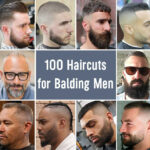Often customers are confused about synthetic hair wigs and human hair wigs. Today we are going to discuss the features and differences between synthetic hair and human hair wigs, and which one is most suitable for your clients.
Synthetic Hair Wigs
Early in its development, synthetic hair was used only in machine-made wigs, which were cheap and unnatural. However, with the development of technology, the quality of synthetic hair has gradually improved, and its appearance has become much more like human hair and is now used as a supplement of human hair materials.
The synthetic hair on the market is divided into many kinds and is mainly produced in China, Korea, and Japan. Various types of synthetic hair come with different characteristics such as different feel, glossiness, weight, durability, which all directly determine the quality of wigs. The most commonly used synthetic fiber in the hair market is Kanekalon which is one of a high-temperature fiber. Kanekalon is more typical in the men’s hair systems whereas high-temperature fiber is associated more with the women’s fashion-wig market.
Human Hair Wigs
Human hair wigs are more complicated and are divided into the following types: Chinese hair, Mongolian hair, Indian hair, Brazilian hair, European hair, etc.
Each hair has its characteristics. Chinese Hair is currently the largest source of raw material for making hair replacement systems. Chinese hair and Mongolian hair are similar, they are relatively harder and straight. After acid treatment, they can be curled, bleached, and dyed and conform to any style to meet the clients’ needs. Brazilian hair is similar to the Indian hair. They are thin and soft and usually have small waves. This hair is easily broken after chemical treatment. This renders Indian hair wigs less durable and would have a shorter lifespan than wigs made of Chinese hair. European hair is the most expensive hair raw material. The color of European hair is closer to the hair types found in the European and American consumer markets. It is very thin, soft, not suitable for any chemical treatment, and it is used primarily for hair extensions.

Human hair can also be divided into virgin hair, Remy hair and normal hair. First, natural hair has many cuticles and follows the same direction, just like fish scales, which ensures that hair doesn’t tangle with each other.
Virgin hair is braided hair cut from a person’s head. The hair cuticles are oriented in the same direction and have never been dyed or curled. Therefore, virgin hair retains the natural quality and is the most expensive and best material in human hair.
Remy hair is the hair that hair root and the tip is not upside down too but it may have had some chemical treatment like dying, curling or slight acid treatment. Sometimes, the raw material of hair replacement systems is virgin hair but clients may ask for the hair to be dyed or curled in the factory. So, after the unit is finished, the hair is not virgin hair anymore as it has become Remy hair.
Normal hair, also known as Non-Remy hair, refers to hair with inconsistent order of hair root and hair tip. Since the tip-to-top direction of the hair is very disorderly, the hair will undergo some very heavy acid treatment to remove all the cuticles on the hair. Therefore, this hair is soft and thin, and its service life is shorter than other human hair.
Hair systems with different types of human hair will have different effects and appearance. European hair, for example, is very soft and thin, so the hair will lay down close the base which is suitable for the clients who want a flat effect. Chinese hair, on the other hand, is stiffer and thicker so it can create a lift-effect of the hair on the base. Consequently, advising clients which is the most suitable type of human hair for them is a very important and interesting topic. If interested, click here to learn more:
Characteristics of Different Types of Human Hair
What are the differences between synthetic hair and human hair wigs?
1. From a cost point of view, synthetic hair wigs are much cheaper than human hair wigs. Since more and more people are dying and curling their hair, less and less is being collected to be used for hair replacement systems. So, the cost of human hair has become higher and higher. However, synthetic fiber does not and will not encounter such problems. We can produce as much synthetic fiber as we want.
2. Even though synthetic fiber techniques have advanced. Some top-quality fiber is very similar to real human hair but it is still not exactly the same as human hair. The touch and feel are not as soft and smooth as human hair. The difference is particularly apparent when someone uses a brush to brush their hair.
3. Human hair can be dyed; synthetic fiber cannot be. Human hair can be dyed to another color again after we have finished the unit but we cannot dye synthetic fiber pieces even if it is just a case of dyeing the hair from a very light color to a slightly darker one.
4. Human hair will fade; synthetic fiber will not.
5. Styling human hair is harder than synthetic fiber. When we try to style or curl human hair, we need to use chemicals to make it easier to style the hair but we don’t need too many styling products for synthetic fiber. It can be settable easier with any new styling or curl.
6. Styling or curling is easier with synthetic fiber than human hair as previously stated. However, once hot hair is applied to synthetic fiber, all the curls will disappear. This is not true of human hair which can hold curls for a long time.

7. From a manufacturing perspective synthetic fiber, like other plastic fibers, when pulled and stretched hard and passed through some small narrow holes, will easily become tortuous after knotting. Human hair, on the other hand, is protein so it does not easily become tortuous.

Which is the right option for your clients?
You get what you pay for. Generally speaking, although 100% synthetic hair wig is cheap, the appearance can look fake. 100% human hair wigs are more expensive, but have a realistic-looking appearance and are more comfortable to wear. Which one is best depends on the clients’ budget, needs, and expectations.
If used temporarily, such as for festivals, performances, etc., synthetic wigs are a more economical and more reasonable choice. We recommend a human hair wig for daily use because it is more realistic and comfortable. A few times, a mix of human and synthetic hair is used for men’s hair systems and this mix can make the hair more responsive and easier to style. Another advantage of this method is when a customer needs to blend in some gray hair. Choosing gray synthetic hair can ensure the color of gray hair does not change when customers dye the whole piece another color by themselves because the synthetic material is not easy to be dyed.
How to Distinguish Human Hair and Synthetic Hair Wigs?
The wig market has a long history of both good and bad mixed. It’s very important for hairpiece wholesalers to learn to distinguish between human hair wigs and wholesale synthetic hair wigs. For experienced professionals, it is quite easy to distinguish both types by appearance and touch. But if you’re a newcomer, you need to pay attention to whether the supplier partner is providing what you are ordering. So, how do we distinguish between human and synthetic hair?
The first method is to look at the gloss. As mentioned above, synthetic hair is very bright, but the sheen of human hair is very natural. The second is how it feels to the touch. Human hair feels smooth and soft, while synthetic hair feels a bit hard and easy to knot. It will be rolled up after a while use. Third, when using a hairdryer at high temperatures to blow-dry the hair, synthetic hair will deform and fluff, and human hair will not be blown. Fourth, pull a few hairs and burn them with a lighter. After burning, human hair smells similar to burned wool and becomes powdery. The smell of synthetic hair is like the smell of burning plastics, it is very pungent and has little knots after burning. See the pictures below.






1 thought on “Comparison Between High Quality Synthetic Hair And Human Hair Wigs”
Need videos of Cambodian hair,Indian hair,Vietnam hair,Brazilian hair,Malaysian hair,remy hair (unprocessed hair and virgin hair)